Why should you hardwire a radar detector? Radar detectors need to be plugged in for power and generally ship with a cigarette lighter plug to make it easy to power your detector. However, it looks kinda ugly to have a long cable dangling down your windshield and dash and it can get in the way of using your stereo. It also makes it obvious to others while driving or parked that you have a detector so many people take their RD’s down when parking and put it back up every time they get back in their car.
A good alternative is to hardwire your radar detector by creating a permanent power plug for it.
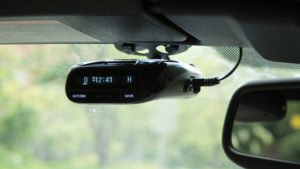
Rather than taking up your cig. lighter outlet, you power your detector from your car’s fuse box and run a power cable hidden along the trim of your vehicle to create a much cleaner and professional looking installation. It allows you to mount your detector high up near your headliner for better radar detection, your detector can be more stealthy behind your tint strip without the cable dangling down so it’s less visible to police or potential thieves, you can leave it in your car with less chance of someone else seeing it, etc. There’s lots of great benefits to doing this and it’s the preferred method to power your radar detector.
You can hire a professional to do this for you. Most any car radio installer can do this and it doesn’t take a lot of time or money, or you can do it yourself. In this tutorial I’ll show you how to do it yourself.
What You’ll Need
- Hardwire cable
- Add-a-circuit fuse tap kit
- T-tap (optional)
Hardwire Cable
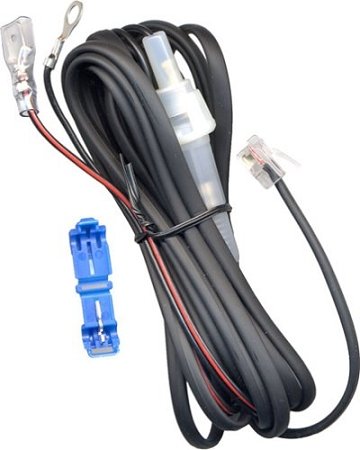
So the power cable that you’re going to need is called a hardwire cable or direct wire cable. It’s basically a long straight cable that connects to a power source on one end and plugs into your radar detector on the other end.
There’s a variety of different types. Your traditional hardwire cable is just a simple power cable. Some fancier ones add in an additional remote mute button and alert LED, some add bluetooth so you can pair your detector to your phone, and so on, but the principles are the same.
There also specialized ones like short cables that plug into your auto-dimming rearview mirror or your OBD-II port to provide you with alternate locations to power your detector from.
If you want to see all the different options, see this article on Radar Detector Hardwire Cable Options. For now to keep things simple, we’re going to talk about just your standard simple power cable that runs down to your fuse box.
Add-a-circuit Fuse Tap
Now to actually get power for your radar detector, you’re going to want to tap into your fuse box.
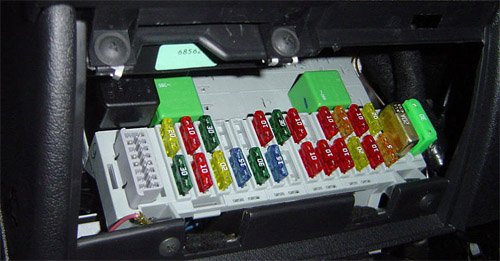
(Image credit: napaonline.com)
The fuse box is located in different places in different cars, but inside you’ll see lots of little fuses for different parts of your car: AC, stereo, power seats, airbags, etc. We’re going to add your radar detector so that it’s also tapping into the fuse box like all your other electronics. (You can do the same thing with your dashcam, laser jammers, phone charger cables, etc.)
To actually tap into the fuse box, you’ll need something called an add-a-circuit.
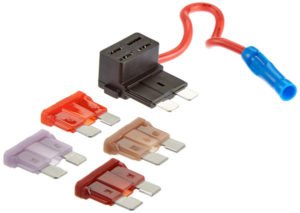
An add-a-circuit lets you add new electronics to your existing fuse box. Now different cars and manufacturers use different size fuses so you’ll need to get the one that’s the right size for your car. You can either Google it, check your car manual, or just pull a fuse out of your car and compare it to the guide below.
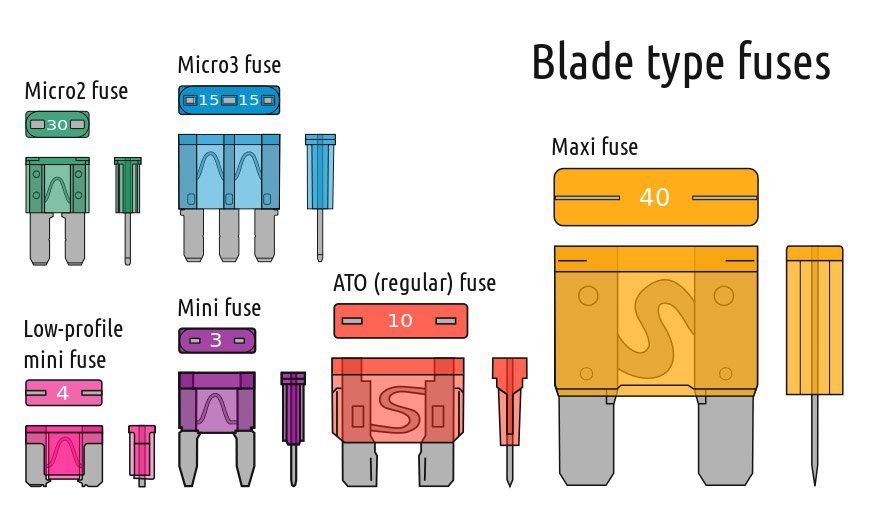
Once you figure out which fuse size you need for your car, you’ll want to pick up an add-a-circuit kit for the the size fuse you need. Here’s where you can get the kits for the most popular fuse sizes:
Low-profile mini add-a-circuit kit
(A kit usually includes both the add-a-circuit cable plus some extra fuses you’ll need for the new devices you’re adding.)
Plug In the Add-A-Circuit
To plug in the add-a-circuit, you’re going to want to find a fuse in your fuse box that turns on and off with your car’s ignition. Generally some circuits are always powered while others are tied to your ignition. You’ll want to use something that turns off when you turn off your car so that your radar detector doesn’t drain and kill your car battery when you’re parked. Then when you start your car up next, your detector turns back on. Now you’ll have to poke around because this is different with every car. To find out what each fuse goes to, you can either check your car’s manual or the diagram that’s often located on the cover to the fuse panel. It’ll look something like this:
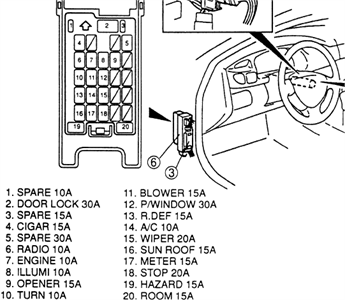
Note: Some cars don’t have any fuses that turn on and off with the car and every single fuse always has power no matter what. If this is the case for you, you may need to turn your detector on/off manually every time. Some GPS-based detectors have an option to automatically turn off when they sense that you haven’t been moving for a long period of time, aka when you’re parked.
Once you’ve found a fuse slot you want to use, you’ll want to pull out the existing fuse. You can use a specialized fuse puller to do this, but if you have a set of thin pliers on hand already, that can often do the job as well.
Once you get the fuse pulled, you’re going to want to put that fuse in your add-a-circuit which has slots for two fuses. The bottom one (farther from the red wire) is the one for the original fuse you just pulled. The top one (in line with the red wire) is for the new accessories (radar detector, etc.) you’ll be adding.
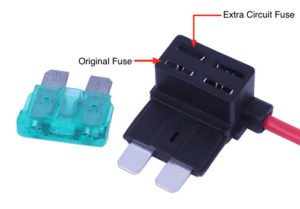
Now the add-a-circuit kits I linked you to above all include some extra fuses specifically for this second slot. You’ll want to add up the maximum power usage used by all your devices and pick a fuse that’s a little larger than all of them combined. For example, if you’re using a RD that uses 500 mA or 1A total, a 2A fuse is good. If you’ll be putting multiple devices on that add-a-circuit, you may want to use a 3A or 5A fuse.
Power is supplied on one side of the fuse slot and is designed to flow across the fuse to the other side. Use your multimeter to figure out which side is powered and then plug in the add-a-circuit so the red wire is on the other side. This way you can ensure the fuse is being used in the circuit.
Here’s the add-a-circuit tapped into my car’s fuse box.
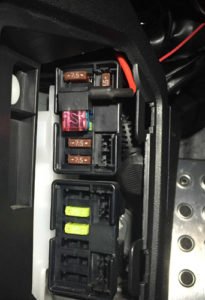
Connecting To The Add-A-Circuit
Once you have your add-a-circuit installed in your fuse box, you’ll need to connect your hardwire cable to it. There’s two main ways to do this.
The first is to use the blue connector on the end of the add-a-circuit. You can strip the end of the power wire of your hardwire cable if it doesn’t come stripped already, insert it into the blue connector, and use a crimper (not pliers!) to crimp down on the blue connector and make a good solid connection. Personally I don’t generally use this option because it only works for one device and it’s not removable if you want to swap hardware later, but it definitely does the job and is a pretty simple solution.
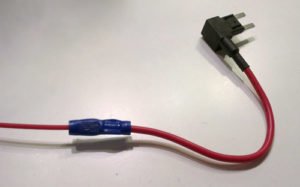
(Image credit: mazdaspeedforums.org)
Your other option is to use a T-tap which bites directly into the red wire itself, making contact with the electrical wire inside it.
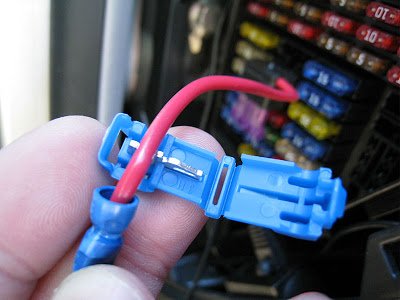
(Image credit: hkwonger.blogspot.com)
You see the metal part inside the blue T-tap? When you close the T-tap, it bites down on the red add-a-circuit cable, cutting through the red insulation, and making contact with the wire inside. It helps to have a set of pliers to squeeze down on the T-tap so that it cuts through the insulation and clicks closed.
Once it’s locked down, you can slide on the matching connector from the hardwire cable (assuming it has one) and you’ve got a power connection for your radar detector.
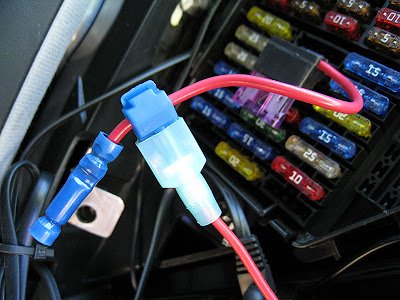
(Image credit: hkwonger.blogspot.com)
Now the add-a-circuit kits I linked you to earlier all include the T-tap and matching connector. The hardwire cable you chose may or may not come with the connector that slides onto the T-tap. If not, you can either buy them separately or just use the crimping trick I showed earlier onto the end of the blue connector. If you need some T-taps and/or connectors, you can get some here. (I usually like to buy a set of them so I can add multiple devices like dashcams, laser jammers, phone chargers, etc. to the add-a-circuit, plus you usually can’t buy just one anyways.)
Connecting Your Ground Wire
Your hardwire cable is made up of two wires: power and ground. Power you get from your add-a-circuit. Ground you’ll need to connect to elsewhere. You can either find a ground wire from some of your existing electronics and tap into it, or you can connect your ground wire to a metal part of your car’s chassis.
If you have a ground wire you can tap into from something else, and there’s often some around the fuse box anyways, that’s the easiest way to go.
If not, look for a part of your car’s chassis or frame, not just some random piece of metal floating around anywhere, and securely affix your ground wire to the chassis and now you’ll have a solid ground for your detector.
Running the Wires
Once you’ve got the hardwire cable connected to your add-a-circuit and ground, it’s a simple matter of plugging everything in and running the wires. You’ll generally want to run the wires from your fuse box, up your A-pillar, across your headliner, and into your radar detector. Often times you can simply tuck the wires behind the body panels, but sometimes you may have to remove panels to get the cleanest install. (Note: Make sure your wire doesn’t run over top of the airbag in your A-pillar!)
Here’s a look at where my hardwire cable is run along my car.
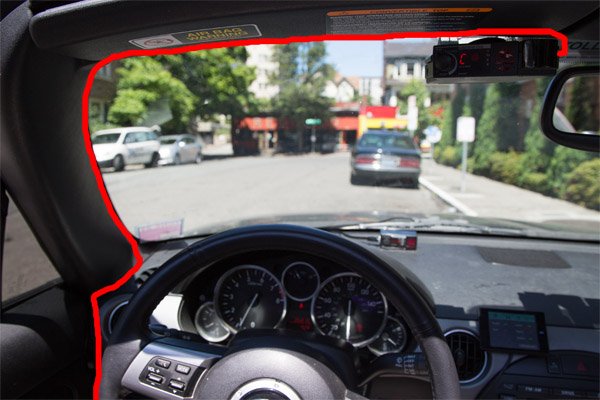
That’s it!
Now you’ve got a professional looking clean install, your cigarette lighter outlet is free for other devices, you can mount your detector in the best possible location for radar detecting performance (up high), and you no longer have to deal with ugly cables hanging down your dash and getting in the way.
Once you get your install completed, feel free to share it with the community in the Show Off Your Install section on RDF.
Enjoy your beautiful new install! 😀
Hardwire a Radar Detector Video Tutorial
Bonus: If you’d like to watch a video walkthrough of the installation process, here’s a video tutorial with me hardwiring both a radar detector and a dashcam into a vehicle.
| This website contains affiliate links and I sometimes make commissions on purchases. All opinions are my own. I don’t do paid or sponsored reviews. Click here to read my affiliate disclosure. |


38 comments
Skip to comment form
Hi Vortex,
Just wondering, if I have multiple devices I’d like to hardwire, for instance a dashcam and my radar detector, can these both be T-tap’d to a single add-a-circuit?
Many Thanks!
– apex
Author
You bet! That’s exactly what I do. 😉
How do I determine if my fuse box is “hot all the time”? I did essentially what you did: direct wire cord and add a circuit and used the radio fuse:
https://images-na.ssl-images-amazon.com/images/I/71yLEAwleWL._SX522_.jpg
https://images-na.ssl-images-amazon.com/images/I/51f6Locn%2BAL._AC_UL160_SR160,160_.jpg
However, my detector doesn’t turn on/off with the car. Instead, I have to manually turn the detector on/off.
Also, several reviews on Amazon (for the direct wire cord) mentioned something about “reverse polarity” – would that have an effect on why it’s “always hot”…?
Author
So there’s a bunch of fuses and they’re all for different things. Some will be for things that should always have power (like your dome lights) while others will be for things that should only work when your car is turned on (like your stereo). It varies from car to car so you may wanna try a different slot in your fuse box.
I used a multimeter and verified that every fuse slot has 12v (hot all the time), even when the car is turned off. In this case, what can I do to direct wire the detector and have it come on/off when the key/engine…?
Author
Yeah this is the case with some vehicles, unfortunately. Some GPS-based detectors come with the ability to shut themselves off automatically when they notice you’ve been stationary (parked) for an extended period of time, this way they don’t drain your car battery. That’s one solution that’d work.
My radar hardwire is interfereing with my tire pressure sensors. Its not allowing the valves to communicate with the computer. Any fix for this so the tire pressure sensor fault light doesnt stay on?
Author
Weird, I’ve never heard of this happening. Maybe try tapping into a different power source if you’re seeing conflicts in where your RD is drawing power from?
So, I took your advice after viewing several of your videos and purchased the Uniden DFR7. I was hoping to hard wire it to my fuse panel but see that it has a RJ45 connector on the power cord. I haven’t been able to find any info on hard wiring this type of power cord to a fuse panel. Can you help?
Author
Sorry I’m not sure what you’re asking. This article you’re commenting on is designed to show you exactly how to do that. You use a hardwire cable, one end goes into your RD and the other end goes into your fuse box. What’s your question, exactly?
The power cord connector to the radar detector isn’t a USB or MICRO, it is a plastic RJ45. I haven’t seen any hard wire kits with this type of connector.
Author
RJ45 is the standard power connector for radar detectors and most hardwire kits are designed for it. Here’s one: https://bit.ly/28TJdLb and here’s another: http://amzn.to/2q7AeeI
Thanks, since my last email I found a hard wire kit for the Uniden on Amazon. Appreciate your help.
I’m planning on adding a uniden R3 radar detector and ALP laser w/ hi-fi speaker set. What size fuse would I need for the add-a-circuit (extra slot)?
Thank you
looks like a 5 amp will work. Good video!
Hello, thank you for such a great web site with so much helpful information! I recently upgraded from the 9500ix to the Max 2 which I picked up used on ebay for $255. I have been extremely happy with the 9500ix and was going to get another one (or the similar S75g) but went with the Max 2 based on your Sept 2017 video comparing the 9500ix, S75g, IX, and Max 2). My question is, my 9500ix was already professionally hardwired in my car including the hardwire with the Escort false/mute button. Can I just plug the Max 2 in to my existing hardware for the 9500ix? Will it work? Can it cause any damage to the Max 2? I am hopefully that would be the case, allowing me to move the old 9500ix to my wife’s new car. If not, can I move all my old hard wiring for the 9500ix to my wife’s car? In which case, I would need new hard wire for the Max 2. Can you recommend on Amazon for Max 2? I do not have power to my mirror on my car. Also, would I need a new mirror mount for the Max 2? I currently have this mount for the 9500ix https://www.amazon.com/gp/product/B0063N7OZ2/ref=ox_sc_act_title_4?smid=A4ZR0KLVOENJ2&psc=1 and if it will no longer work with the Max 2 then I was thinking of getting this mount from Amazon https://www.amazon.com/gp/product/B00TKVCTZE/ref=ox_sc_act_title_2?smid=AL6R9LY9O9FHQ&psc=1 Thoughts? Sorry for the long post. Thank you for whatever input you can give me. I can also be reached directly at [email protected] Thank you.
Author
Hey so the power cables will be 100% compatible so you can continue using your existing one. If you want another one for your new car, you can get them here. http://amzn.to/2EVDFQz There’s two versions with two different color LED’s.
The Max2 uses a different mount though so you will need a new clip to connect to the Max2. http://amzn.to/2EGV5kE If you’re looking to upgrade, you can also look into the Blendmount. Similar idea but a few nice improvements over what you have now. https://www.vortexradar.com/2017/04/blendmount-vs-radar-mount-rear-view-mirror-mount-comparison-review/
Great tutorial! I used it to hard wire the Redline I got late 2016.
Do you mean RJ11, rather than RJ45, as the standard plug for most detectors? My Redline uses a RJ11.
I am thinking of getting the Uniden R3/R1. Will my existing hard wire for the Redline plug into and work with the R3/R1? I have the standard Escort brand hard wire kit with fuse and nothing other than a RJ11 plug (not a SmartCord or anything fancy)? Does R3/R1 use a RJ45? Thanks!
Author
Yeah it’ll work perfectly. I cross Escort, Uniden, and Valentine plugs all the time since they all use the same pinouts. If you had a SmartCord, the remote mute button and alert LED on the cable wouldn’t work, but power would still work. With your plug-only hardwire cable, it’ll work no problem.
I purchased from “Best Radar Detectors” the DIRECT WIRE POWER CORD FOR UNIDEN LRD850, LRD950, DFR6, DFR7, R1 & R3 Part Number:UnidenDW to go with the new Uniden R1 also from them. This cord will not power my R1. I’ve verified power and ground and fuse connections. Do I need to purchase the UNIDEN SMART HARDWIRE KIT W/MUTE BUTTON Part Number:RDA-HDWKT to make this work properly??
Best Radar Detectors has not acknowledged a single question I’ve asked them about this…
Author
That cord definitely should work with the R1. It’s a generic one that works with most any radar detector. Do you have another detector you can test with? There has to be an issue with your wiring and connection. If you have a multimeter, here’s some info about the RJ11 connector pinouts and which pins are power and ground if you’d like to verify that power is making its way through your power cable. https://www.rdforum.org/index.php?threads/60495/
The smart hardwire button will do the same thing while adding more functionality, but in terms of powering your detector, there is no difference.
Great tutorial! I just purchased an R3 and looking to hardwire it. Do I need a “Add-a-circuit Fuse Tap” if I have an empty fuse slot? Thank you.
Author
Double-check to make sure that fuse slot is powered (and that there’s metal inside it). Some are empty slots, placeholders essentially. An add-a-circuit works great with empty, but otherwise, functional fuse slots too.
I dont think I can use the standard type of add a fuse as it will tick out too far and I wont be able to close fuse door after that….is there a different one you can recommend ?
I meant “stick out” too far…my fuse box only has about 3/4 clearance from top of fuse to the door….fuse box on left side of dashboard in between car door
Enjoying my new R7. Wondering if I can just snip off the connector from the cigarette lighter cable that it came with, throw away the coiled section and add a length of correct size wire?
The amperage does not matter with the add-a-circuit connector correct? I want to hardwire my v1 gen 2…. also any recommendations for radar detector mount for v1 gen 2?
Author
You just want something a little bigger than what the V1 will draw. A 2-3 amp fuse should be plenty.
As for the mount, yeah you can upgrade to the Blendmount for a more solid mount without worrying about suction cups failing.
So if I’m using an add a circuit fuse I would want to put it in where I have a 5 amp fuse for example then… or does it not matter if you use the add a circuit fuse?
Author
Pull the current fuse out, put it in the add-a-circuit for the slot for the existing fuse, then put in your new fuse for your RD in the other slot.
I get that I was moreso asking if it matters which fuse slot I put it in… For example a slot that had a 5 amp fuse or one the had a 20 amp fuse
Author
Ah gotcha. It’s usually best to choose a fuse slot that’s for something not safety-related like airbags. Maybe heated seats would be good, for example. The idea is that in case the add-a-circuit falls out, you don’t want it disabling something critical. As far as the amperage limit of the fuse you’re taking out, it doesn’t matter.
Perfect thanks for the response! You’re videos are great by the way very helpful!
HI, Ariel. Thanks for all the great content. I need some troubleshooting help. If there’s an FAQ/troubleshooter you can direct me to that would be great also! I followed your exact steps on 2013 honda accord (mini fuse) and it worked out just fine. I’m now just using the same set up on my audi s6 2020, just bought a new fuse tap medium size and I can’t get ANY fuse to work. I’ve tried driver’s side panel, footwell panel, different fuses just in case?? (ATC, ATO), I’ve switched directions… nothing. The original function still works when I plug it in, the cable still works (it did the last time I used it, don’t have the car anymore to test)… what else can I try? Is it the nature of the car? Should I buy a new cable and see if that works?
Author
Audi’s are weirder. None of the fuses in my Q5 are switched. I think it’s just the nature of the beast and you may need to get fancier and create a relay that’s triggered on some other source. I had my installers do that for me when I had all the work done on my car. You can do that same thing if you like, or you can have a pro add it to your vehicle if that’s the same issue you’re seeing.
I’m thinking of using one of these for my V1 gen 2: https: https://www.gen5diy.com/products/14-18-yukon-radar-detector-harness
Anyone have things in this approach?
Thank you, but i have questions.
1) can i use cigarette lighter fuse slot? the fuse itself rated 20amp.
2) if i will use the above fuse slot, which fuse should i use for the RD (3,5,10 etc.)?
3) thank you in advance.
Another question.
I’ve understand that i have to know which side is the load side of the fuse.
Iv’e tried with multimeter (including put the black prone to earth and the red to the fuse box) but i have no results.